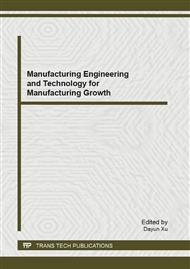[1]
Vieira, C. A. B., Susin, S. B. S., Freire, E., Amico, S. C., Zattera, A. J., Characterization of hybrid composites produced with mats made using different methods, Materials Research, Vol 12, No. 4 (2009) 433-436.
DOI: 10.1590/s1516-14392009000400011
Google Scholar
[2]
Schmidt, T. M., Goss, T. M., Amico, S. C., Lekakou, C., Permeability of hybrid reinforcements and mechanical properties of their composites molded by resin transfer molding, Journal of Reinforced Plastics and Composites, 28 (2009) 2839-2850.
DOI: 10.1177/0731684408093974
Google Scholar
[3]
Karina, M., Onggo, H., Dawam Abdullah, A. H. ve Syampurwadi, A., Effect of oil palm empty fruit bunch fiber on the physical and mechanical properties of fiber glass reinforced polyester resin. Journal of Biological Sciences, 8 (2008) 101-106.
DOI: 10.3923/jbs.2008.101.106
Google Scholar
[4]
Kalaprasad, G., Francis, B., Thomas, S., Kumar, C. R., Pavithran, C., Groeninckx, G., Effect of fiber length and chemical modifications on the tensile properties of intimately mixed short sisal/glass hybrid fiber reinforced low density polyethylene composites, Polymer International, 53 (2004).
DOI: 10.1002/pi.1453
Google Scholar
[5]
Paiva Junior, C. Z., De Carvalho, L. H., Fonseca, V. M., Monteiro, S. N., D'Almeida, J. R. M., Analyses of the tensile strength of polyester/hybrid ramie-cotton fabric composites, Polymer Testing, 23 (2004) 131-135.
DOI: 10.1016/s0142-9418(03)00071-0
Google Scholar
[6]
Panthapulakkal, S., Zereshkian, A., Sain, M., Preparation and characterization of wheat straw fibers for reinforcing application in injection molded thermoplastic composites, Bioresource Technology, 97 (2005) 265-272.
DOI: 10.1016/j.biortech.2005.02.043
Google Scholar
[7]
Haneefa, A., Bindu, P., Aravind, I., Thomas, S., Studies on tensile and flexural properties of short banana/glass hybrid fiber reinforced polystyrene composites, Journal of Composite Materials, 42 (2008) 1471-1489.
DOI: 10.1177/0021998308092194
Google Scholar
[8]
Samal, S. K., Mohanty, S., Nayak, S. K., Banana/glass fiber-reinforced polypropylene hybrid composites: Fabrication and performance evaluation, Polymer-Plastics Technology and Engineering, 48 (2009) 397-414.
DOI: 10.1080/03602550902725407
Google Scholar
[9]
Jarukumjorn, K., Suppakarn, N., Effect of glass fiber hybridization on properties of sisal fiber-polypropylene composites, Composites Part B: Engineering, 40 (2009) 623-627.
DOI: 10.1016/j.compositesb.2009.04.007
Google Scholar
[10]
Mishra, S., Mohanty, A. K., Drzal, L. T., Misra, M., Parija, S., Nayak, S. K., Tripathy, S. S., Studies on mechanical performance of biofiber/glass reinforced polyester hybrid composites, Composites Science and Technology, 63 (2003) 1377-1385.
DOI: 10.1016/s0266-3538(03)00084-8
Google Scholar
[11]
Idicula, M., Neelakantan, N. R., Oommen, Z., Joseph, K., Thomas, S., A study of the mechanical properties of randomly oriented short banana and sisal hybrid fiber reinforced polyester composites, Journal of Applied Polymer Science, 96 (2005).
DOI: 10.1002/app.21636
Google Scholar
[12]
Kartalis, C. N., Papasprides, C. D., Pfaendner, R., Recycling of post-used PE packaging film using the restabilization technique, Polymer Degredation and Stability, 70 (2000) 189-197.
DOI: 10.1016/s0141-3910(00)00106-3
Google Scholar


